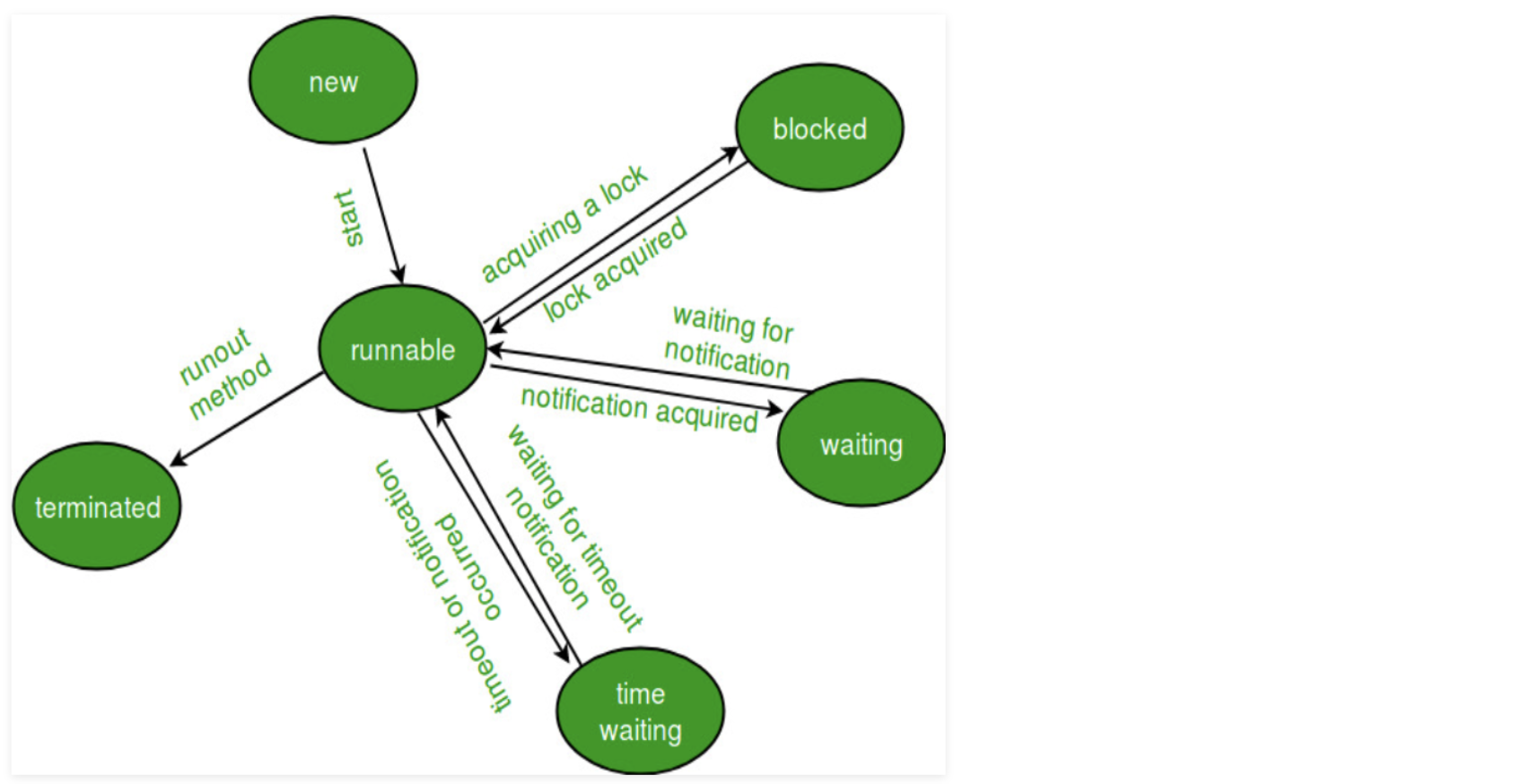Java執行狀態分析1:執行緒及執行緒狀態
阿新 • • 發佈:2019-07-13
執行緒
執行緒(英語:thread)是作業系統能夠進行運算排程的最小單位。它被包含在程序之中,是程序中的實際運作單位。一條執行緒指的是程序中一個單一順序的控制流, 一個程序中可以併發多個執行緒,每條執行緒並行執行不同的任務。在Unix System V及SunOS中也被稱為輕量程序(lightweight processes), 但輕量程序更多指核心執行緒(kernel thread),而把使用者執行緒(user thread)稱為執行緒。
以上拷貝自維基百科
程式碼中任務、邏輯操作都依賴於執行緒,是java執行時最寶貴的資源
多執行緒一定程度可以增加cpu使用時間,壓榨計算機資源提供更好的使用效能,一定程度也增加了資源的消耗如記憶體的增長、執行緒上下文資料切換的消耗、cup資源消耗,實際情況中我們應該根據業務場景合理的使用執行緒資源
Java執行緒生命週期
 

java.lang.Thread.State 定義瞭如下6種執行緒狀態
/** * Thread state for a thread which has not yet started. */ NEW, /** * Thread state for a runnable thread. A thread in the runnable * state is executing in the Java virtual machine but it may * be waiting for other resources from the operating system * such as processor. */ RUNNABLE, /** * Thread state for a thread blocked waiting for a monitor lock. * A thread in the blocked state is waiting for a monitor lock * to enter a synchronized block/method or * reenter a synchronized block/method after calling * {@link Object#wait() Object.wait}. */ BLOCKED, /** * Thread state for a waiting thread. * A thread is in the waiting state due to calling one of the * following methods: * <ul> * <li>{@link Object#wait() Object.wait} with no timeout</li> * <li>{@link #join() Thread.join} with no timeout</li> * <li>{@link LockSupport#park() LockSupport.park}</li> * </ul> * * <p>A thread in the waiting state is waiting for another thread to * perform a particular action. * * For example, a thread that has called <tt>Object.wait()</tt> * on an object is waiting for another thread to call * <tt>Object.notify()</tt> or <tt>Object.notifyAll()</tt> on * that object. A thread that has called <tt>Thread.join()</tt> * is waiting for a specified thread to terminate. */ WAITING, /** * Thread state for a waiting thread with a specified waiting time. * A thread is in the timed waiting state due to calling one of * the following methods with a specified positive waiting time: * <ul> * <li>{@link #sleep Thread.sleep}</li> * <li>{@link Object#wait(long) Object.wait} with timeout</li> * <li>{@link #join(long) Thread.join} with timeout</li> * <li>{@link LockSupport#parkNanos LockSupport.parkNanos}</li> * <li>{@link LockSupport#parkUntil LockSupport.parkUntil}</li> * </ul> */ TIMED_WAITING, /** * Thread state for a terminated thread. * The thread has completed execution. */ TERMINATED;
- New:剛建立,可被執行,並且未開始執行
- Runnable:正在執行或隨時準備執行,例如多執行緒程式分配特定時間片給特定執行緒,特定執行緒執行短暫時間並暫停放棄cpu時間給其他執行緒,其他執行緒因此可以執行,這種場景執行緒是準備執行等待CPU時間,這種狀態即Runnable
- Blocked:waiting for a monitor lock,處於需要獲取其他執行緒鎖定的同步資源,如等待io結束,這種狀態在轉變為Runnable之前無法執行,無法消耗cup時間片
- Waiting:等待其他執行緒執行特定操作,和Blocked類似
- Timed Waiting:執行緒呼叫等待執行場景,特定時間後執行,比較sleep,或者一些條件等待場景,如定時任務
- Terminated:正常或異常結束執行緒,將不分配CPU時間
模擬執行緒生命週期
1執行緒狀態轉換
public class DemonstrateThreadStates2 {
static Thread thread1;
public static void main(String[] args) {
//建立執行緒1
thread1 = new Thread(new TestThread1());
// thread1 建立後 NEW state.
System.out.println("State of thread1 after creating it - " + thread1.getState());
thread1.start();
// thread1 呼叫start後 變成 Runnable state
System.out.println("State of thread1 after calling .start() method on it - " +
thread1.getState());
}
}
class TestThread1 implements Runnable {
@Override
public void run() {
TestThread2 myThread = new TestThread2();
Thread thread2 = new Thread(myThread);
// 執行緒2建立 NEW state.
System.out.println("State of thread2 after creating it - " + thread2.getState());
thread2.start();
// 執行緒2呼叫start 變成 Runnable state
System.out.println("State of thread2 after calling .start() method on it - " +
thread2.getState());
// 呼叫sleep迫使當前執行緒進入sleep thread2 = timed waiting state
try {
//moving thread2 to timed waiting state
Thread.sleep(200);
} catch (InterruptedException e) {
e.printStackTrace();
}
System.out.println("State of thread2 after calling .sleep() method on it - " +
thread2.getState());
try {
// 呼叫join迫使執行緒結束到die
thread2.join();
} catch (InterruptedException e) {
e.printStackTrace();
}
System.out.println("State of thread2 when it has finished it's execution - " +
thread2.getState());
}
}
class TestThread2 implements Runnable {
@Override
public void run() {
// moving thread2 to timed waiting state
try {
Thread.sleep(1500);
} catch (InterruptedException e) {
e.printStackTrace();
}
System.out.println("State of thread1 while it called join() method on thread2 -" +
DemonstrateThreadStates2.thread1.getState());
try {
Thread.sleep(200);
} catch (InterruptedException e) {
e.printStackTrace();
}
}
}
控制檯輸出:
State of thread1 after creating it - NEW
State of thread1 after calling .start() method on it - RUNNABLE
State of thread2 after creating it - NEW
State of thread2 after calling .start() method on it - RUNNABLE
State of thread2 after calling .sleep() method on it - TIMED_WAITING
State of thread1 while it called join() method on thread2 -WAITING
State of thread2 when it has finished it's execution - TERMINATED
執行緒建立執行緒變成NEW狀態,呼叫start啟動執行緒變成Runnable,呼叫sleep阻塞當前執行緒吧變成Timed Waiting,thread2呼叫join將等待結束當前執行緒到父執行緒thread1,thread2執行緒將變成die,父執行緒thread1 等待執行緒thread2結束變成waiting
2模擬blocked場景
通過死鎖模擬blocked場景
死鎖條件
互斥使用:一個資源只能分配給一個執行緒
不可剝奪:資源只能由佔有者釋放,申請者不能強制剝奪
請求保持:執行緒申請資源時,保持對原有資源的佔有
迴圈等待:存在一個程序等待佇列:{P1 , P2 , … , Pn}, 其中P1等待P2佔有的資源,P2等待P3佔有的資源,…,Pn等待P1佔有的資源,形成一個程序等待環路
程式碼
public class TestDeadLock implements Runnable {
// flag=1,佔有物件o1,等待物件o2
// flag=0,佔有物件o2,等待物件o1
public int flag = 1;
// 定義兩個Object物件,模擬兩個執行緒佔有的資源
public static Object o1 = new Object();
public static Object o2 = new Object();
public static void main(String[] args) {
TestDeadLock deadLock1 = new TestDeadLock();
TestDeadLock deadLock2 = new TestDeadLock();
deadLock1.flag = 0;
deadLock2.flag = 1;
Thread thread1 = new Thread(deadLock1);
Thread thread2 = new Thread(deadLock2);
thread1.start();
thread2.start();
}
@Override
public void run() {
System.out.println("flag: " + flag);
// deadLock2佔用資源o1,準備獲取資源o2
if (flag == 1) {
synchronized (o1) {
try {
Thread.sleep(1000);
} catch (InterruptedException e) {
e.printStackTrace();
}
synchronized (o2) {
System.out.println("1");
}
}
}
// deadLock1佔用資源o2,準備獲取資源o1
else if (flag == 0) {
synchronized (o2) {
try {
Thread.sleep(1000);
} catch (InterruptedException e) {
e.printStackTrace();
}
synchronized (o1) {
System.out.println("0");
}
}
}
}
}
參考文獻
https://www.geeksforgeeks.org/lifecycle-and-states-of-a-thread-in-java/
